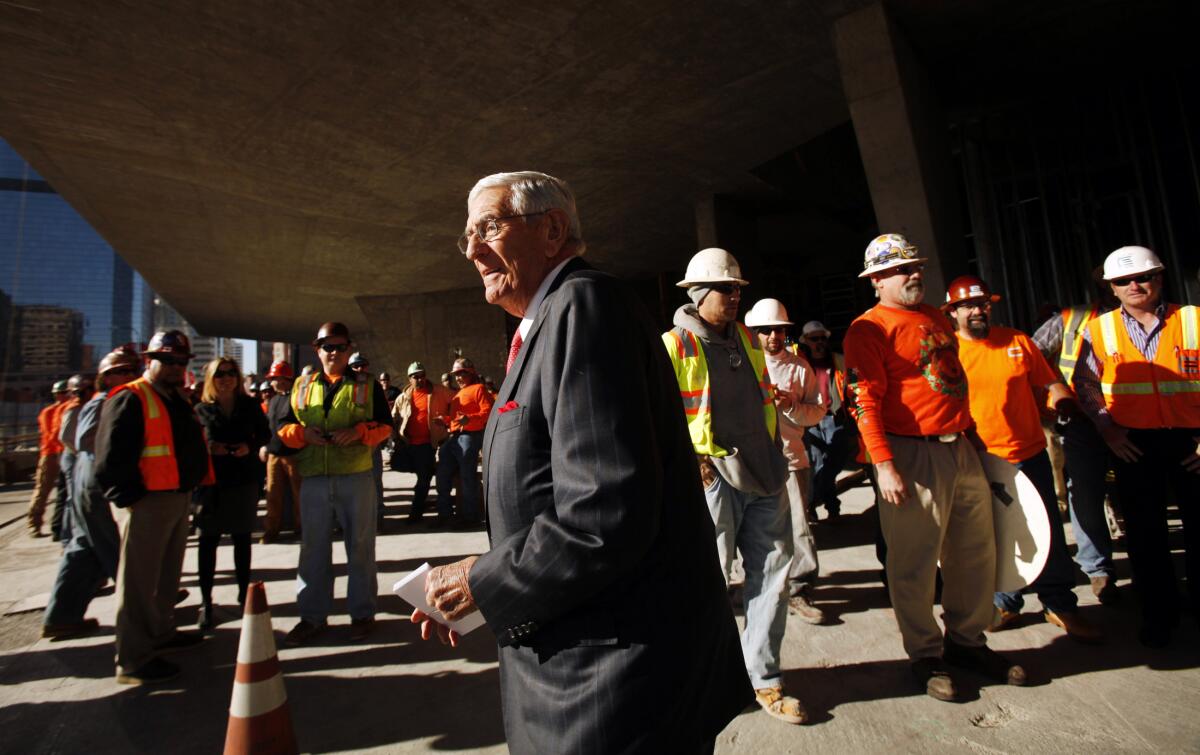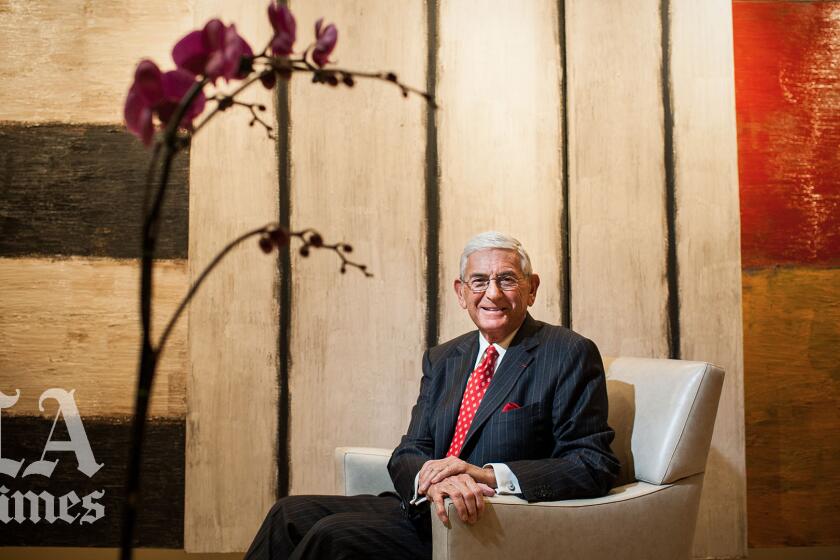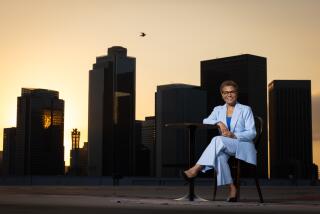Op-Ed: Eli Broad, leader for a city that doesn’t want to be led

- Share via
The story of Eli Broad and Los Angeles has something of the dynamic of the unstoppable force meeting the immovable object. As a young man, Eli came to L.A., full of conviction and ambition and certitude, and arrived in a place that was famously — then and now — resistant to leadership.
Broad would have been a leader wherever he landed. He was strong and visionary. He founded not one but two gigantically successful companies, both predicated on giving baby boomers what they needed as they grew older: their first homes and then insurance and retirement services. But he was drawn by opportunity, and he was at the head of a home building company that prospered with sprawl. Where else but L.A.?
If Los Angeles suited his business ambitions, however, it challenged his emergent sense of leadership and power. He wanted to be big, and Los Angeles, unlike San Francisco, treats its leaders warily. In today’s California, a former San Francisco mayor, Gavin Newsom, presides as governor, a position no Los Angeles mayor has ever held. Just last week, former San Francisco district attorney and now Vice President Kamala Harris sat beside Speaker of the House Nancy Pelosi in places of honor behind President Biden as he addressed Congress for the first time. It was widely noted as the first time two women occupied those seats; it also was a showcase for San Francisco — not Los Angeles.
Broad did not accept that Los Angeles could not be led. That was most apparent when the 1992 riots that followed the state verdicts in the Rodney King case drained Los Angeles of its self-confidence. In the fear and anger exposed by the riots, it seemed plausible that L.A. was doomed to fall apart. Time magazine wondered out loud whether Los Angeles was “going to hell.”
Broad had supported his friend Richard Riordan for mayor, and Riordan’s election in 1993 was built on the idea of turning Los Angeles around. Once in office, Riordan asked Broad to spearhead what would become the most symbolically significant effort in that work: the completion of Walt Disney Concert Hall. Up to that point, Disney Hall was a parking garage with no building atop it, a project that had run aground and a symbol of the city’s inability to get things done.
Joined by the less-heralded but equally important Andrea Van de Kamp, Broad set out to prove that the project could be completed. He dragged the city’s billionaire class into the business of supporting downtown and Los Angeles itself. When he was finished, the city had its greatest building. More importantly, it had regained the confidence that big things could actually get done here. Frank Gehry’s masterpiece is also a monument to Broad’s determination to make Los Angeles work again.
That was not the beginning of Broad’s place in civic life — he had supported Mayor Tom Bradley and Sen. Alan Cranston, among other leaders; helped found the Museum of Contemporary Art, among other institutions — but it catapulted him to the leadership of the city’s reenergized business and philanthropic community.
He championed cultural tourism and steered the city’s museums toward that idea, donating strategically and using his own collection as a lure. He worried about the effects of an underperforming school system and believed charter schools were an important tool for improvement, so he backed their proponents at the ballot and in their ground game. He fretted over the endless changes of ownership and leadership at the Los Angeles Times, a topic we discussed dozens of times.
He spent millions upon millions on schools, museums, stem-cell research centers. Sometimes, however, he treated his donations more like investments.
A city that resists leadership was bound to have problems with Broad, and he had plenty of critics. He could be brusque — it sometimes seemed his natural state, despite his easy and often-photographed smile. Teachers unions were suspicious of him, and some of his benefactors resented the strings he attached to donations. The criticism was sometimes ludicrous — Broad never forced anyone to accept his money — but power attracts resentment, and Broad attracted his share.
It did not seem to bother him. I once asked him what his response was to those who might not share his taste in architecture, for instance, since he was consciously attempting to impose his sensibilities on the city’s buildings. He looked puzzled.
“I have yet to hear many people complain about contemporary architecture downtown, whether it’s our museum, Walt Disney Concert Hall, the cathedral, etc.,” he told me in 2017. “It’s the art of our times. I mean, if people want to have a colonial home or something, that’s fine.”
He plowed ahead, donating, demanding, building. It was that last idea, of himself as a builder, that he seemed most to enjoy. And today’s Los Angeles, from its schools to its political leadership to its skyline, reflects Broad’s great construction project.
The defining characters of the last 30 years in Los Angeles have made different contributions. Former Secretary of State Warren Christopher was a wise, soft-spoken counselor in the aftermath of the King unrest; state Sen. María Elena Durazo was and is a powerful organizer of workers and immigrants; Father Greg Boyle is a generous spiritual force.
There’s no ranking such people — this city is in debt to each of them — but Broad was in a class by himself. In his case, the unstoppable force pushed the immovable object, and the object moved. We’re better for it.
Jim Newton, a former editorial page editor of The Times, now edits Blueprint magazine at UCLA. His most recent book is “Man of Tomorrow: The Relentless Life of Jerry Brown.”
More to Read
A cure for the common opinion
Get thought-provoking perspectives with our weekly newsletter.
You may occasionally receive promotional content from the Los Angeles Times.











